On Monday, September 4, 2023, the first phase of the Blue Rail Line will start operating for commercial purposes, according to the Lagos State Government (LASG). Governor Babajide Sanwo-Olu and other passengers will board the first train, departing from Marina to the Mile 2 train station at 9 a.m.
The LASG had earlier stated that the Blue and Red Lines would open by December 2022, but there have been various delays in the rail line’s opening. Governor Babajide Sanwo-Olu told journalists in May this year that the rail line would start operating commercially in June as the state government was finalizing plans for an 18-megawatt independent power source to run it.
The Lagos Metropolitan Transport Authority’s (LAMATA) managing director, Abimbola Akinajo, stated that the completion of the rail line’s electrical fittings was the reason for the delay in the start of commercial operations and that the flag-off was scheduled for the last week of August 2023.
“At the moment, we’re making sure the electrical systems are in working order. About 150,000 people have travelled on the rail line so far. Still, commercial operations won’t begin until the last week of August, according to Akinajo, whose organization oversees the Blue Line rail’s operations.
Lagosians have been keen to see the blue train line open for business, especially as they struggle with expensive transportation costs brought on by the recent removal of fuel subsidy, which increased the pump price to 600 naira per litre.
Recall that on January 24, 2023, President Muhammadu Buhari inaugurated the first section of the Blue Rail Line in Lagos State (from Marina to Mile 2). The President, Lagos State Governor Babajide Sanwo-Olu, and his deputy, Obafemi Hamzat, inaugurated the project at the State’s Marina Train Station. Additionally, the President was present when Phase 2 of the project, from Mile 2 to Okokomaiko, was officially launched.
The Lagos Rail Mass Transit’s Blue Rail line, which spans 27.5 km from Marina to Okokomaiko and has 13 stations, will take 35 minutes to complete end-to-end. With no level crossings and unrestricted access for people or vehicles, the entire Blue Line will run on a safe and exclusive right-of-way. The 13-kilometre Lagos Blue Line rail service began a two-month test run in February 2023 under the State Government.
Lagos Blue Rail Line Mode of Operation
The Blue Line project is a 27-kilometre rail line connecting Marina and Okokomaiko through Ijora after travelling east to Mile 2. Thirteen kilometres (13 km) of rail tracks were installed in the first phase, and the five stations have been finished. The Blue Line’s first phase, which has five stations at Marina, National Theatre, Orile, Suru, and Mile 2, is 13 km long. Phase two will double that distance to 27 km. When the entire 27km is finished, it will carry roughly 500,000 passengers daily, with the initial phase taking 250,000 daily. Four coaches make up each train, comfortably accommodating 180 people.
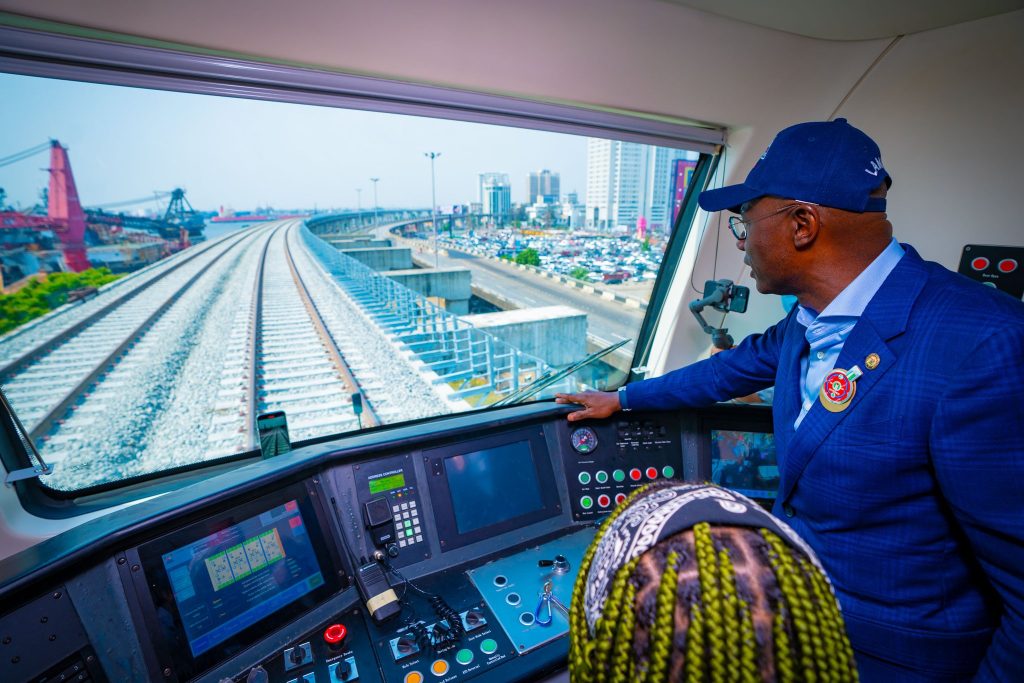
Over the first four weeks, the train can only make twelve trips with the locomotive system. After a month, LAMATA will start running 76 trips on electric power, carrying an estimated 150,000 to 175,000 people daily from 6:30 a.m. to 10 a.m. during morning peak hours and 4 p.m. to 10 p.m. during afternoon and evening hours. At each station, the train will only stop for 90 seconds.
Time Table for Lagos Blue Rail Line Train Ride
Below is the timetable for the first phase of the inaugural train ride, starting on Monday, September 4, 2023:
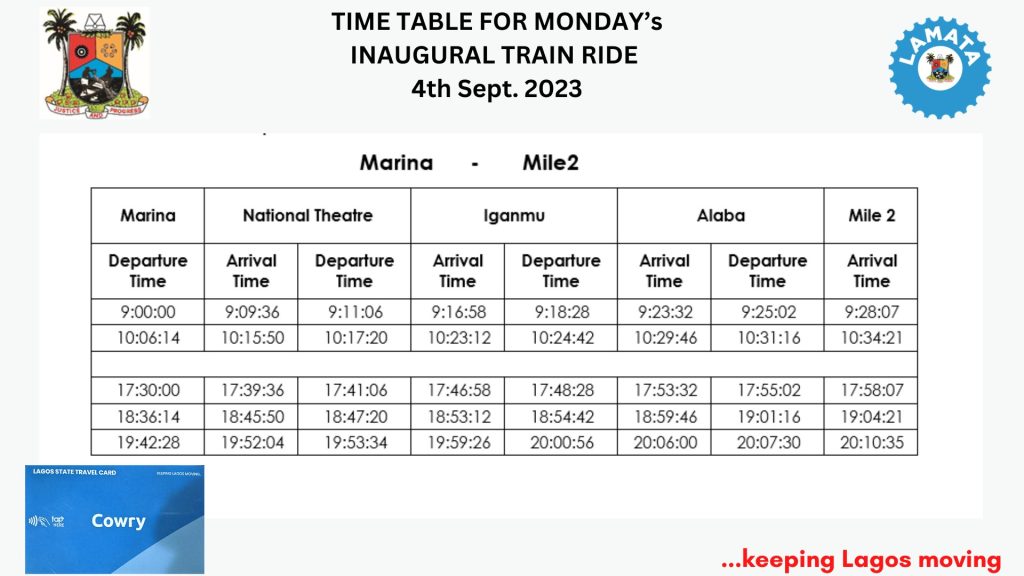
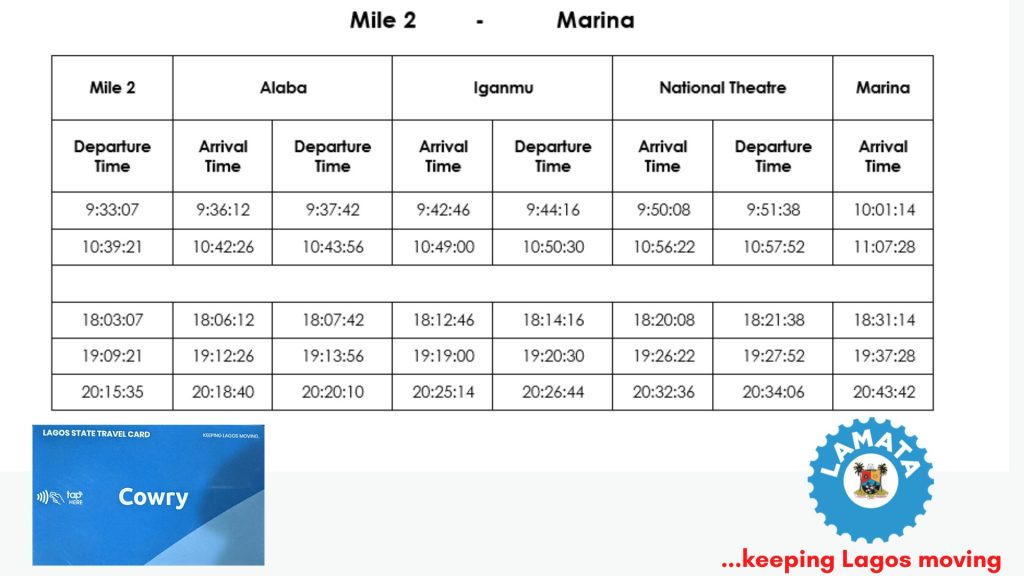
Cost of Lagos Blue Rail Line
Lagos Blue Rail line will be considered in the transport palliative outlined by Governor Sanwo-Olu. Each journey would cost N750, half the price of the Lagos Blue rail line, pending when the palliative is over. The cost of boarding will be 1,500 naira per journey for the blue rail line.
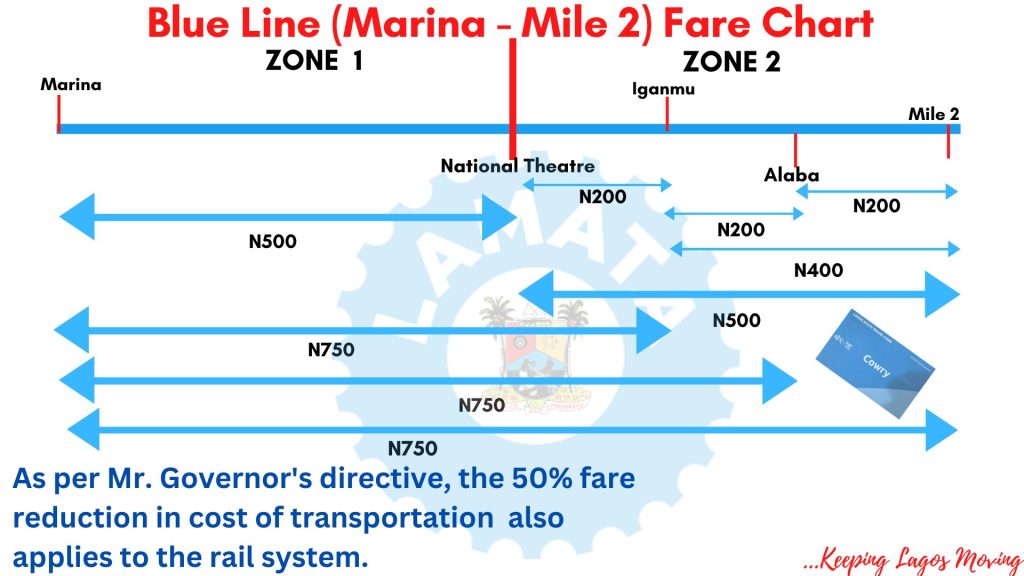
How to Pay for the Lagos Blue Rail Line?
The Lagos Cowry card with the touch-and-pay system is already prepared for use at the station. The fare gates at National Theatre Station are now open, according to Jubril Gawat, the governor’s senior special adviser for new media. Riders can use the system using their contactless Cowry Card, the State’s unified electronic payment system now in use for regulated ferry services and Bus Rapid Transit.
Conclusion
The Lagos Mass Transit System features other rail lines throughout the State and the Blue Line and Red Line railway systems. These consist of the following: Green line: Marina to Lekki Free Zone Orange line: Ikeja to Agbowa Yellow line: Otta to National Theatre Brown line: Mile 12 to Marina Purple line: Redemption Camp to Ojo Green line: Marina to Lekki Free Zone.
In addition to using existing transportation corridors when practicable, the Lagos Blue Rail Line will connect the State’s major population and activity centres.
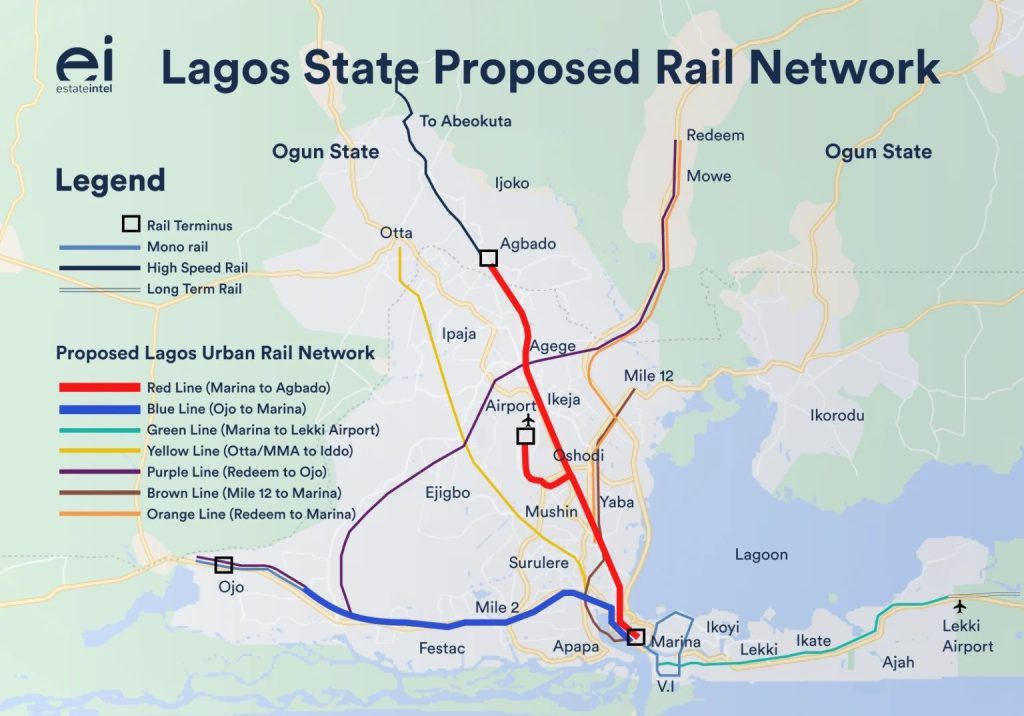
Frequently Asked Questions (FAQs)
When did the Lagos Blue Line start?
Former President Muhammadu Buhari launched the first phase of the Blue Line rail project in Lagos on January 24, 2023. The project planned to extend from Mile 2 (on the mainland) to Marina (on the island), was tested by Lagos State Governor Babajide Sanwo-Olu before the inauguration.
Who started the Lagos Blue Line?
The train network was first suggested in 1983 by the Lateef Jakande administration, and it was officially launched in 2003 by Bola Tinubu, an ex-governor of the State.
What are the blue line stations in Lagos?
The Blue Line’s stations include Marina, National Theatre, Orile-Iganmu, Suru-Alaba, Mile 2, and Okokomaiko as its terminus in the Ojo region of the State.
What are the routes of trains in Lagos?
The intercity line consists of two major routes: Iddo to Otta, the new Blue Rail line from Mile 2 to Marina, and Lagos to Ibadan train station.
Does the Lagos Blue Train have WiFi?
The Lagos Blue Line train offers complimentary Wi-Fi for commuters.
Where is the Lagos Blue Line?
The Blue Line’s first phase includes five stops at the Marina, National Theatre, Orile-Iganmu, Suru-Alaba, and Mile 2. Phase 2 will double the length of the line to 27 km, with Okokomaiko serving as its terminus in the Ojo region of the State.
How much is the Lagos Blue Line?
According to reports, the Blue Rail line was given a contract worth $182 million rather than the $1.2 billion the state government had stated the project would cost.
How much did the blue rail cost in Lagos?
According to reports, the Blue Rail line was granted $182 million instead of the $1.2 billion the state government had stated it would cost. “Those who made the outlandish claim apparently relied on a document ascribed to CRCC, the parent corporation of CCECC.
How long is the Lagos light rail?
Over 500,000 people are anticipated to use Lagos’ 27-kilometre-long Blue Line rail line once it is finished. With a daily capacity of 250,000 passengers, the initial phase travels via five stations over a distance of 13 km.
How fast is the train on the Lagos Blue Line?
The project’s first phase has the capacity to carry more than 200,000 passengers daily at a speed of 80 km/h, with trains expected to reach each stop in 3 to 5 minutes. When the project is finished, over 400,000 daily passengers will be moved.
How many new railway lines are being built to connect Lagos?
The Lagos Metropolitan Area Transport Authority (LAMATA) is creating the Lagos Rail Mass Transit System on behalf of the Lagos State Government (LSG), which is funding the project. Seven lines in the network have been proposed by LAMATA: Red, Blue, Green, Yellow, Purple, Brown, and Orange.
Is there an electric train in Nigeria?
The Lagos State Government recently tested the first stage of the Blue Rail Line project’s yet-to-be-commissioned first phase. When it starts operating, the 13-kilometer electric-powered rail will have five stations and carry roughly 250,000 passengers daily. It runs from Mile 2 to Marina.
Is Lagos Blue Rail Electric?
Electric Multiple Unit (EMU), a separate power source, will power the train.
Is the Lagos Blue Rail working?
After several testing stages, the Lagos Blue Rail Line will commence full operation on September 4, 2023.
What is the new train in Lagos?
The Lagos State Government has announced that on Monday, September 4, 2023, the Blue Line Rail will start operating normally. It will move from Marina to Mile 2 on the Blue Line Rail.
What is the green line in Lagos State?
A 68-kilometer rail-based commuter service called the Green Line Rail Project will run between Marina and the Lekki Free Trade Zone. Under advantageous business circumstances, the proposed project will be built through a Build-Operate-Transfer (BOT) public-private partnership.
What is the Lagos Red Line?
The Lagos Rail Mass Transit (LRMT) scheme includes the red line. Agbado to Marina would be reached via a 37-kilometer rail line that would stop at 13 stations along the way: Agbado, Iju, Agege, Ikeja, MMIA International, MMIA Domestic, Oshodi, Mushin, Yaba, Ebute-Metta, Iddo, and Marina.
How long is the Lagos Red Line?
When complete, the 37 km Red Line will travel through eight stations and transport passengers from Agbado to Oyingbo.
What is the fastest train in Nigeria?
Babajide Sanwo-Olu, the Governor of Lagos State, purchased the 330 km/h trains from Talgo Group, a high-speed passenger train manufacturer with headquarters in Madrid. The ‘Red Line’ rail is anticipated to start making money between the fourth quarter of 2022 and the first quarter of 2023.
How many new railway lines are being built to connect Lagos?
The Blue Line and Red Line are two lines that are still being built. The five proposed lines are Brown, Orange, Purple, Green, and Yellow.
How much did the Lagos Metro Rail Transit cost?
According to The Infrastructure Bank Plc’s managing director, Mr Adekunle Oyinloye, the projected Lagos Metro Rail Transit (LMRT) project will cost N456 billion (2.4 billion).
Who created Lamata?
Asiwaju Bola Ahmed Tinubu (1999–2007), the then-governor of Lagos State, signed the bill creating the Lagos Metropolitan Area Transport Authority (LAMATA) into law on January 13, 2002.
Is there a train from Lagos to Abuja?
You can travel from Lagos to Abuja on the Ibadan-Abuja railway, which takes between 13 and 15 hours. For those going to Kaduna, you can also make a transfer at the Abuja station.
Who built the Lagos-Ibadan railway?
China Civil Engineering Construction Corporation received a $1.53 billion contract in 2012 to build the 156 km Lagos-Ibadan segment of the standard gauge railway by 2016.
How fast is the Lagos-Ibadan train?
The Lagos to Ibadan train runs at 200 km/h.
Does a Nigerian train use fuel?
The Nigerian Railway Corporation (NRC) officials claim that even though the Corporation only makes up to N1.7 million per day, it consumes over 24,000 litres of diesel for the Lagos–Ibadan route daily, costing about N4 million.
What is the first railway line in Nigeria?
The British colonial authorities built the first railway line between Lagos and Ibadan between 1898 and 1902. The system was finished by the government of a newly independent Nigeria with the line between Kano and Maiduguri, today the epicentre of the Boko Haram Islamist insurgency.
Which is the largest railway in West Africa?
With a capacity to hold 6,000 passengers, the Ebute Metta Station, also known as the Mobolaji Johnson Station, is the biggest railway station in West Africa. Nigeria.
What is the name of the train station in Abuja?
Idu Station, also known as Abuja’s Interstate Train Station.
Where is the Nigerian Railway Headquarters?
The Corporation’s headquarters are in Lagos at Ebute-Metta, and the entire network is separated into seven autonomous districts for administrative purposes.

